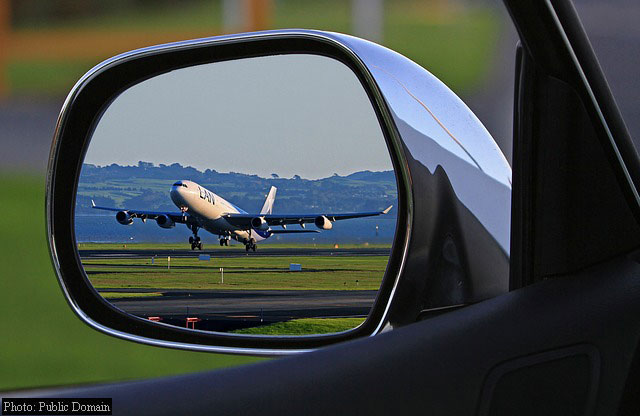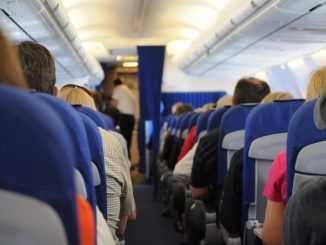
If I go to a Broadway show, my seat does not recline. More important, at least to me, is that neither does the seat in front of me.
I don’t get a reclining seat at the baseball stadium or the basketball arena. I have never been on a city subway or bus where the seat reclines. Heaven forbid we should ever experience a reclining seat in a house of worship. Like everyone else, I get by in all these places with no more than manageable discomfort.
So why on earth do airlines persist in installing reclining seats in their economy-class cabins? These are cabins in which every centimeter of supposedly excess space has been removed in the interest of economic efficiency. Yet on most planes, flight attendants still ask passengers to place their seats in the upright position for takeoff and landing, because at least some passengers will make use of their tilting privileges in between. Why continue this increasingly absurd state of affairs?
It can’t be because customers expect airline seats to recline. For one thing, customers used to expect free food and checked baggage, both of which are long gone on most tickets. For another, reclining seats in coach made some sense back in the days when economy cabins provided up to three feet of seat pitch – the distance between a given point on one seat to the same point on the seat behind it – between rows. As of last fall, the maximum pitch in economy had declined a full five inches on United, and the minimum pitch had declined two inches. The space-squeezing tactics are similar on other legacy airlines.
Reclining seats were reasonable back when there was space to recline into, and when in-flight service included real meals served on genuine china and flatware. We do not live in that world today.
Certain economy seats are already locked in place on major carriers, particularly those in front of bulkheads and exit rows. I have heard more than one customer loudly complaining about this fact, because other seats sold in the same cabin were more accommodating.
Part of the problem is there is no general consensus on the proper etiquette for reclining. A survey last fall suggested 41 percent of fliers thought it was “very” or “somewhat” rude to recline your seat at all, no matter what the circumstances. Other passengers feel entitled to the space as something they paid for with their ticket price. “If the seat construction includes the ability to lean back, use it,” one traveler told USA Today. “This is not the passenger’s problem. It’s the airline’s problem.”
Airlines seem to disagree. Because they continue to install reclining seats even as they chip away at the space per passenger in the economy cabin, reclining becomes a heated negotiation between passengers. Sure, in a perfect world, we would all reach civilized compromises with the travelers in front of and behind us. But airline travel is stressful, and we are not always at our best while on board. These tensions become magnified when we disagree about the fundamental etiquette surrounding reclining.
Today’s coach cabin is a Darwinian battlefield of undersized seats making an increasingly large number of people feel oversized in comparison; carry-on bags whose owners often cannot carry them, let alone lift them into overhead bins; and Knee Defenders, an obnoxious (and largely banned) device designed to prevent the passenger in front of you from doing what his seat would otherwise let him do.
Is it any surprise that tempers sometimes flare?
In extreme cases, things get even worse. Last fall, traveler James Beach, who is over 6 feet tall, attempted to use a Knee Defender on a United Airlines flight. (United is among the airlines that have banned the devices.) Beach evidently skipped the included “courtesy card,” which many critics have noted is hardly courteous in anything more than name, informing the person ahead of you that you are the one locking the seat in place. The woman sitting in the row ahead contacted a flight attended to complain that she couldn’t lean back, assuming the seat was broken. Beach confessed to using a Knee Defender, and the situation devolved into a fight that resulted in the flight being rerouted to eject both passengers at an unplanned stop in Chicago.
Beach later said he was “pretty ashamed and embarrassed by what happened,” but his story became a flashpoint for debates about reclining. Etiquette expert Anna Post observed that “two rudes don’t make behavior polite,” in reaction to the incident, despite coming down against the Knee Defender as a concept.
Of course, a minority of people will behave terribly on airlines, reclining seats or no. Within the past month, a Southwest flight between San Diego and Chicago was forced to divert to Amarillo, Texas, because six passengers fought with the flight attendants and refused to follow crew instructions. And a JetBlue (JBLU) passenger horrified those around him by urinating in the cabin of a flight bound for Portland, Oregon. Such extreme misbehavior is rare, but not certainly not unheard of. People misbehave everywhere, but the inconvenience to everyone else is magnified in an enclosed space with no way to remove the offenders.
I am making no excuses for passenger behavior that is boorish or worse. But why provoke an already tense situation by continuing to invite people to recline into the shrinking space allowed to their fellow traveler? Why continue to pit passengers who want to catch a bit of rest on a flight against passengers who want to work on a laptop or who are simply too tall to spare any space above their knees?
It is unrealistic to expect airlines to return any space to economy cabin seats at this point. So the solution should be obvious: Put seat backs in economy cabins in one fixed position. It certainly need not be perfectly perpendicular to the floor. I am sure there are ergonomic studies that show what approximate angle of recline would be generally comfortable, or at least less uncomfortable, for the greatest number of passengers.
Find that angle and install seats with this optimal degree of recline, no less and certainly no more. Let everybody have an equally “comfortable” flight and give passengers one less thing to fight about.
- Bulenox: Get 45% to 91% OFF ... Use Discount Code: UNO
- Risk Our Money Not Yours | Get 50% to 90% OFF ... Use Discount Code: MMBVBKSM
Disclaimer: This page contains affiliate links. If you choose to make a purchase after clicking a link, we may receive a commission at no additional cost to you. Thank you for your support!





Leave a Reply